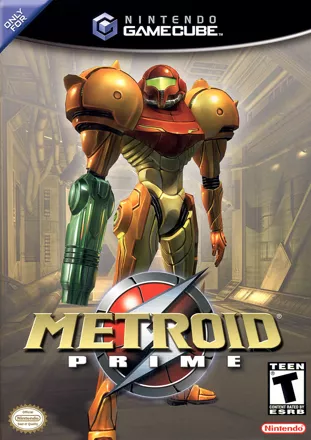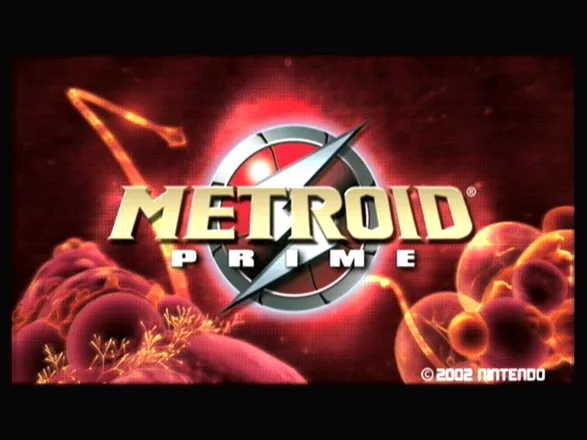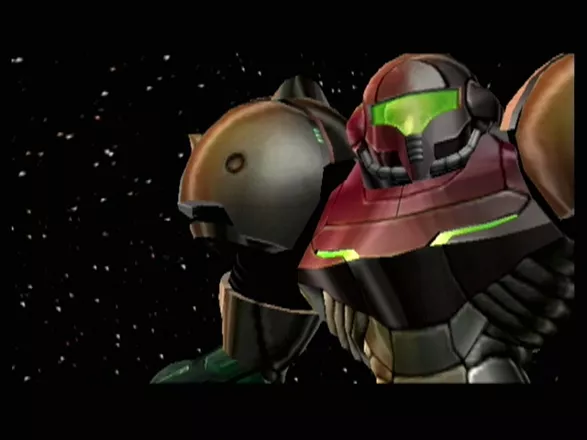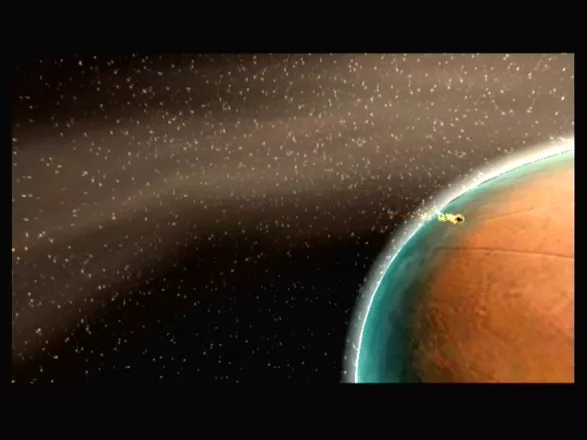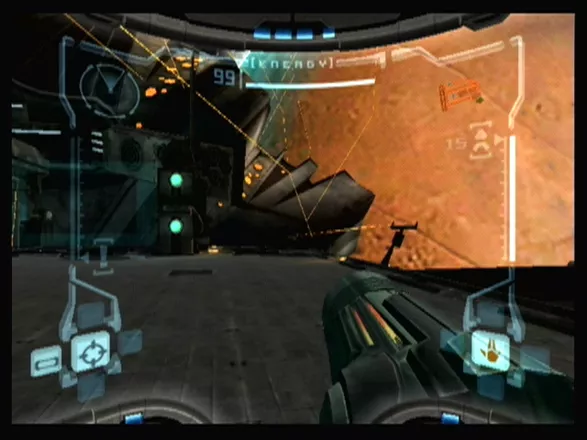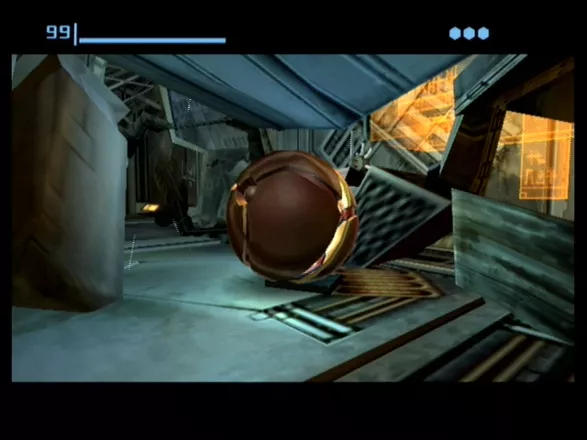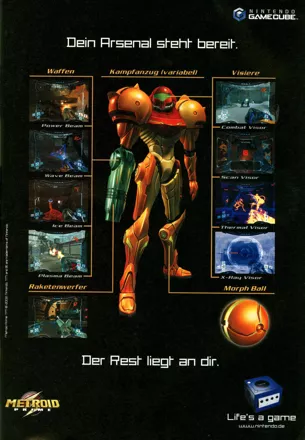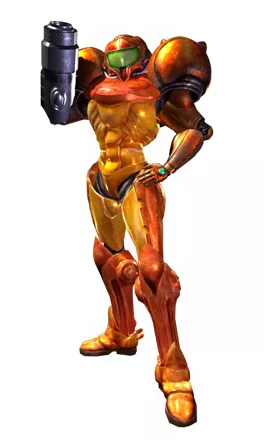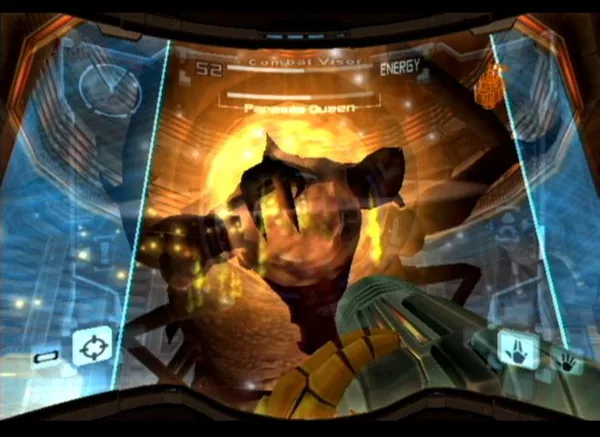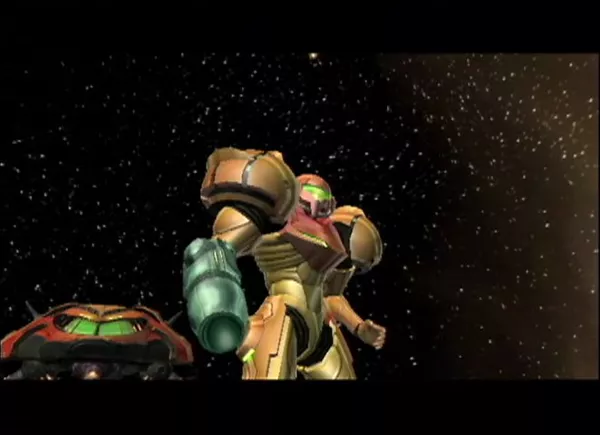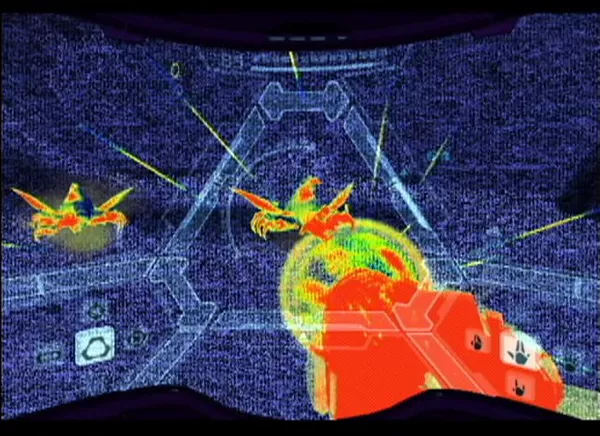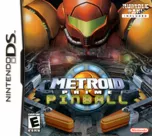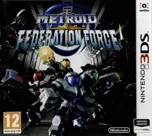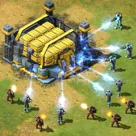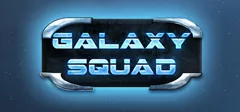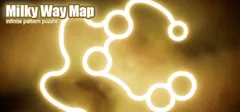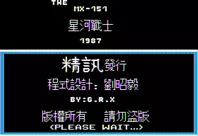Metroid Prime
Description official descriptions
Long ago, a bird-like race of creatures (called the Chozo) became extremely advanced technologically, but due to increasing violence in the universe, they began to hide and live more simple lives. The planet Tallon IV was the site of one of their colonies. Years later, a meteor crashed on Tallon IV releasing the strange element Phazon into the planet. Phazon poisoned anything it came in contact with, causing the plant and animal life to either die or mutate into a hideous form.
The Chozo tried to control the power of Phazon but failed. Before abandoning the planet, they were able to cover the impact crater with a temple and seal Phazon into the planet's core. Now space pirates have discovered Tallon IV, moving in to study Phazon and harnessing its power. They have also begun rebuilding their fortress on planet Zebes and reviving the Mother Brain, Ridley, and Kraid, all of whom were destroyed by Samus Aran. However, Samus has tracked the space pirates to Tallon IV and must now enter the planet to destroy them once and for all before they have a chance to rebuild their destructive forces...
Metroid Prime is a change from the platform-adventuring series, entering the first-person shooter genre for the first time. Players are now behind Samus Aran's visor and must use all their resources to investigate the pirate infestation of Tallon IV. Players can use Samus's beam, with missile and charge capabilities. Along the way, they must recover the bounty hunter's lost abilities like the morph ball and grapple beam, which allow them to reach unexplored areas of Tallon IV. Players must piece together the story of the fallen Chozo to figure out what has happened to the poisoned planet and prevent the pirates from using the Phazon to wreak havoc throughout the planets.
Spellings
- メトロイドプライム - Japanese spelling
- 银河战士 - Chinese spelling (simplified)
- 메트로이드 프라임 - Korean spelling
Groups +
Screenshots
Promos
Videos
See any errors or missing info for this game?
You can submit a correction, contribute trivia, add to a game group, add a related site or alternate title.
Credits (GameCube version)
123 People (101 developers, 22 thanks) · View all
| Executive Producer | |
| Producer | |
| Lead Designer | |
| Senior Designers | |
| Designers | |
| Lead Engineer | |
| Technical Lead Engineers | |
| Senior Engineers | |
| Engineers | |
| Lead Artist | |
| Senior Artists | |
| [ full credits ] | |
Reviews
Critics
Average score: 96% (based on 94 ratings)
Players
Average score: 4.2 out of 5 (based on 238 ratings with 16 reviews)
An epic adventure that helped me understand the genre
The Good
Metroid Prime sure is a Metroid game, just a different kind of one. It definitely helped me to understand the series as a whole. I'd definitely recommend this game as everyone's first Metroid game to try - it isn't as hard as the previous games and is interesting all the way.
The controls are great. Even if, in FPSes, I can't really hit anything without a mouse and keyboard, the controls were never a problem for me. The controls emphasize strategy rather than reflexes - the point is to know how to blast the creatures away, to try to hit things.
The graphics are some of the best I've ever seen. Everything looks great. Lots of attention to details. I especially liked the various weather effects and visor effects (the face reflection spooked the heck out of me the first time I saw it).
The music is also pretty good. I didn't like it at first, but after you get to the planet and do some major moves, the music in general changes to something indescribably great.
There's some great pacing. As I say below, only the bosses were demotivating, every other challenge in the game seems just right.
I also found the game pretty good plot/narration-wise - the approach of collecting scraps of information on what really happened is a good idea.
The Bad
There was just one thing that I really didn't like about: The boss fights were, shall we say, demotivating. They weren't impossible, but they were just, at first, humiliatingly difficult. And by "humiliating", I mean "embarrassing enough not to make me touch the thing for weeks". Of course, once I did beat, say, Flaahgra and Thardus, and even the last boss without getting completely clobbered in the first phase... well, let's just say that the joy of victory was even higher then.
A smaller point I didn't like was that 100% scan completion requires some extremely sharp wits - If you miss some enemies at certain point of game, you can say goodbye to the 100% scan rate. Okay, it isn't really relevant, since it only gives you certain off-game bonuses, but still...
And this is probably the first game ever where I've had moral or ethical problems (as in "I can't kill that, it's too cute!")...
The Bottom Line
I don't really like first-person shooters, but I do love it when people grab their first-person shooter engines and do something completely different with them. I loved mysteriously creative Quake mods. I loved Deus Ex.
So, it wasn't really unexpected that I liked Metroid Prime. The one big thing about FPSes that I dislike is that you've always got to be either running or sneaking or dying. Metroid Prime, then, is sometimes about running and sneaking. It isn't that often about dying, though that tends to happen too.
Metroid Prime is about exploration. I hate to throw cliches around, but I think the appropriate one here is "the journey is more important than the destination".
It's about gathering items. It's also about gathering information. It's about seeing great places. It's about finding out what happened. It's about getting things done. It's about, I think, being a hero.
It is an adventure. It works beautifully as an adventure.
I used to think Metroid series was too complex for me, but now, I think I have learned to understand it. And that wasn't easy at first. Now, I think, I do know what this all is about.
Of all games I've bought for GameCube, I thought this was the one I'd least likely to beat - but somehow, I did, and I'm definitely one great experience richer now that I have beaten it. And excuse me, now, I'll get back playing Metroid Prime 2...
GameCube · by WWWWolf (444) · 2004
The one that doesn't come out but once a generation...
The Good
Everything about this game is so good it makes you forget about anything you could think of wrong with it. The sound, graphics, game play, and controls are all excellently done.
The Bad
That I can't play it 24/7 without having to go to the bathroom or go eat or sleep...
The Bottom Line
This is the game you look for to come out once every consoles generation, and you know there won't be another one like it for that particular game platform unless they make a sequel for it. This game is so good that you can't put it down until then end, and when you do finally finish it, you find yourself going back through it to see if you can find anything you may have missed or any secrets that may be contained in it.
The game play is immersive and entertaining, and the way the story is presented to you is wonderfully done in a "search for the clues" type manner so that you never get bored doing only one thing all the time.
The graphics are seamless, the sound is perfect, the controls are right one que. Everything about this game begs for it to be a part of you gamecube library, so don't miss it and get it as soon as you can!!!
GameCube · by Angela Nichols (1) · 2003
Worthy of the Metroid name. Very worthy.
The Good
How lucky I was that I got a chance to play Metroid Prime. Metroid Prime is Retro's atttempt to take the 2D Metroid series through the 3 dimensional gateway. It was very, very succesful.
Where else to start but the graphics? Metroid Prime looks amazing. Polygon and texture count is amazingly high, and everything looks so real. The enemies, levels, objects and so on have been so finely designed that they reflect on how much work was stuffed into this game. I can very well say this is one of the best looking GameCube released.
Sound quality was also remarkable. While I'm not one who really cares about sound in video games, Metroid Prime drew me to it. The effects are very well created, and sound very real. As with the backround music, which has the right atmospheric condition to draw you into the game. Sound is a very good aspect of this game.
What's a game without good gameplay? Definitely not Metroid Prime. The game plays very smoothly, no jags, long loads, slow downs, or any of that other stuff. The levels are so well designed that you could just run around in one for hours and not get tired. While the game is in the first person view, it is not a FPS(first person shooter). Sure, you have a weapon that you shoot stuff with, but MP distinguishes itself so obviously. The game focuses on exploration instead of non-stop shooting action. Levels need comprehending to complete, not just blazing guns. And oh yes, the ball transforming is back, and better than ever.
The Bad
Every game has a downside. Every game except Metroid Prime, that is.
The Bottom Line
As a loyal XBOX fan, I find myself wanting a GameCube just so I can have this game. Metroid Prime is one of the Golden games that have been released, and will definitely be known as one of the greatest. I give Metroid Prime a well-earned, solid, enthusiastic 5 out of 5.
GameCube · by ThE oNe (180) · 2002
Trivia
1001 Video Games
The GameCube version of Metroid Prime appears in the book 1001 Video Games You Must Play Before You Die by General Editor Tony Mott.
Development
Nintendo gave the development of Metroid Prime to the U.S. based Retro Studios in part due to the fact that the Metroid series, while being incredibly popular in the United States, has never sold as well in Japan.
Retro Studios also worked on a role-playing game for GameCube called Raven Blade of which a video was shown during E3 2001. However, in late 2001, it was announced that the game was canceled by Nintendo so that focus would be more on Metroid Prime. As a result, an unspecified amount of workers were laid off.
Manual
The manual has an amusing problem. Like in many of the Nintendo manuals, there is a lined page for the player's own notes, but the page has light lines on a very dark background. This makes most pen marks practically invisible, so the page is almost useless for its intended purpose (this applies to the Finnish/Swedish original release manual, at least).
Metroid Fusion
After finishing Metroid Fusion on the GBA, and linking up to a GameCube: * A new suit will be available * It will be possible to play the original Metroid on the GameCube
References
Kraid, from Metroid, was originally intended to make an appearance in Metroid Prime as a boss and was modeled and skinned by Gene Kohler for that purpose. However, time constraints prevented it from being included in the final version of the game. Though the beta version displays him inside Phazon Mines, according to Kohler, he was in fact replaced by the Omega Pirate. Kraid is referenced, however, in Metroid Prime. One of the tanks in the Space Pirate's base suggests that one of the Pirate's experiments is to recreate the creature. Body parts in the vat appear to be Kraid's. Of note is the head, since it appears to be covered by a metal dome in the picture.
Screw Attack
While many of Samus' signature moves are present in Metroid Prime, the infamous screw attack is strangely missing. Fans speculate that this is due to difficulties meshing it with the first-person perspective of the game. The screw attack does appear in Metroid Prime 2: Echoes.
Awards
- 4Players
- 2003 – Best Console Action Game of the Year (GameCube)
- Electronic Gaming Monthly
- February 2006 (Issue #200) - #52 in the "Greatest Games of Their Time" list
- GameSpy
- 2002 – Game of the Year
- 2002 – GameCube Game of the Year
- 2002 – GameCube Game of the Year (Readers' Choice)
- 2002 – Best Music of the Year (GameCube)
- Golden Joystick Awards
- 2003 - Runner up as GameCube Game of the Year (after The Legend of Zelda: The Wind Waker)
Information also contributed by ~~, Mark Ennis, Steve Thompson, Tiago Jacques, and WWWWolf .
Analytics
Related Sites +
-
Metroid Prime
Nintendo's Official Site. -
Metroid Wiki
A Wiki site for the Metroid series.
Identifiers +
Contribute
Are you familiar with this game? Help document and preserve this entry in video game history! If your contribution is approved, you will earn points and be credited as a contributor.
Contributors to this Entry
Game added by Servo.
Wii added by gamewarrior.
Additional contributors: Unicorn Lynx, Guy Chapman, gamewarrior, Big John WV, Cantillon, Patrick Bregger, piltdown_man, Rik Hideto, FatherJack.
Game added November 20, 2002. Last modified October 22, 2024.


